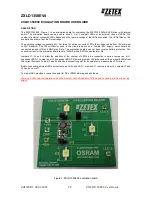
Tomcat i915 S5120
Chapter 3: BIOS Setup
3-6
http://www.tyan.com
of the total number of clock cycles. This results in the processor "resting" for 50-70% of the
time.
As the die temperature drops, the TCC will gradually reduce the number of null cycles until no
more is required to keep the die temperature below the safe point. Then the thermal sensor
turns the TCC off. This mechanism allows the processor to dynamically adjust its duty cycles
to ensure its die temperature remains within safe limits.
The Delay Prior To Thermal BIOS feature controls the activation of the Thermal Monitor's
automatic mode. It allows you to determine when the Pentium 4's Thermal Monitor should be
activated in automatic mode after the system boots. For example, with the default value of 16
Minutes, the BIOS activates the Thermal Monitor in automatic mode 16 minutes after the
system starts booting up.
Generally, the Thermal Monitor should not be activated immediately on booting, as the
processor will be under a heavy load during the booting process. This causes a sharp rise in
die temperature from its cold state. Because it takes time for the thermal output to radiate from
the die to the heat sink, the thermal sensor will register the sudden spike in die temperature
and prematurely activate the TCC. This unnecessarily reduces the processor's performance
during the booting up process.
Therefore, to ensure optimal booting performance, the activation of the Thermal Monitor must
be delayed for a set period of time.
It is recommended that you set this BIOS feature to the lowest value (in minutes) that exceeds
the time it takes to fully boot up your computer. For example, if it takes 5 minutes to fully boot
up your system, you should select 8 Minutes.
You should not select a delay value that is unnecessarily long. Without the Thermal Monitor,
your processor may heat up to a critical temperature (approximately 135°C), at which point the
thermal sensor shuts down your processor by removing the core voltage within 0.5 seconds.
•
4 Min
•
8 Min
•
16 Min
•
32 Min
Thermal Management
Thermal Management throttles the processor back as it reaches its maximum operating
temperature. Throttling reduces the number of processing cycles, thereby diminishing the heat
dissipation of the CPU. This cools the unit. Once the CPU has reached a safe operating
temperature, thermal throttling is automatically disabled, and normal full speed processing
begins again.
The BIOS supports two types of thermal management.
•
Thermal Monitor 1:
Thermal Monitor 1 uses a highly accurate on-die temperature
sensing circuit in the CPU that has the ability to act quickly upon any thermal issues
(~50ns). This circuitry keeps an eye on the most taxed areas of the CPU-die at all
times and will quickly act upon temperatures going over the safety limits. The
thermal monitor’s control circuit, when active, lowers the CPU temperature by
throttling the internal CPU clock speed. This is done with a 50% duty-cycle, which
means that a 2GHz CPU will then effectively run at a 1GHz clock speed. Due to the
fast response time of the thermal monitor circuit (~50ns) the CPU will only be
‘throttled’ for a very brief period. Once the CPU-die temperature is within safe
operating limits again it’ll set back to the 2GHz clock speed it originally operated at.
•
Thermal Monitor 2:
Thermal Monitor 2 decreases or increases the CPU clock and
core voltage according to the CPU load. This information is read from the five VID
pins of the CPU. Accordingly, the CPU temperature is also automatically decreased,
when the core voltage is decreased. This improves the CPU lifespan. The states
switch is so fast that the performance decrease is insignificant.
















































